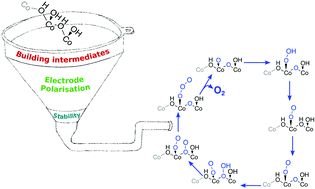Two-sites are better than one: revisiting the OER mechanism on CoOOH by DFT with electrode polarization†
Abstract
We uncover the existence of several competitive mechanisms of water oxidation on the β-CoOOH (10–14) surface by going beyond the classical 4-step mechanism frequently used to study this reaction at the DFT level. Our results demonstrate the importance of two-site reactivity and of purely chemical steps with the associated activation energies. Taking the electrochemical potential explicitly into account leads to modifications of the reaction energy profiles finally leading to the proposition of a new family of mechanisms involving tetraoxidane intermediates. The two-site mechanisms revealed in this work are of key importance to rationalize and predict the impact of dopants in the design of future catalysts.



 Please wait while we load your content...
Please wait while we load your content...